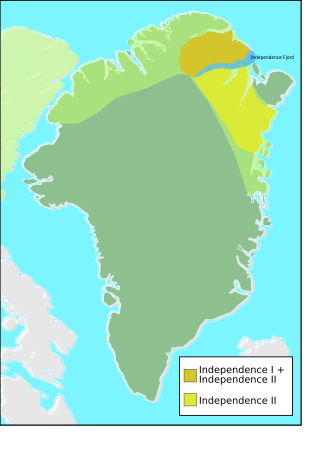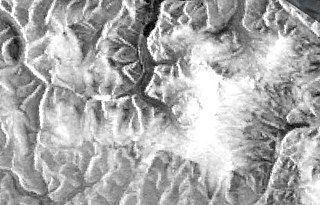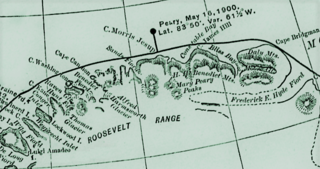
Peary Land is a peninsula in northern Greenland, extending into the Arctic Ocean. It reaches from Victoria Fjord in the west to Independence Fjord in the south and southeast, and to the Arctic Ocean in the north, with Cape Morris Jesup, the northernmost point of Greenland's mainland, and Cape Bridgman in the northeast.

Independence I was a culture of Paleo-Eskimos who lived in northern Greenland and the Canadian Arctic between 2400 and 1900 BC. There has been much debate among scholars on when Independence I culture disappeared, and, therefore, there is a margin of uncertainty with the dates.

Independence II was a Paleo-Eskimo culture that flourished in northern and northeastern Greenland from around 700 to 80 BC, north and south of the Independence Fjord. The Independence II culture existed in roughly the same areas of Greenland as the Independence I culture, which became extinct six centuries before the beginning of Independence II.
Brønlundhus, on some maps also Brønlundfjord, is a former research station and radio station located on the western shore of Jørgen Brønlund Fjord in southern Peary Land, in northern Greenland. It is named after Greenlandic Arctic researcher Jørgen Brønlund, or after the namesake fjord on which it is located. It is close to the mouth of Jørgen Brønlund Fjord where it opens into Independence Fjord.
Count Eigil Knuth was a Danish explorer, archaeologist, sculptor and writer. He is referred to as the Nestor of Danish polar explorers. His archaeological investigations were made in Peary Land and adjacent areas of High Arctic Greenland. Knuth was made a Knight of the Dannebrog.

Frederick E. Hyde Fjord is a fjord in Peary Land, far northern Greenland.
Deltaterrasserne is a pre-Inuit occupation archaeological site located near the head of Jørgen Brønlund Fjord on the Peary Land peninsula in northern Greenland. It is one of the largest archaeological sites in Peary Land, and was discovered in September 1948 by the Danish explorer and archaeologist Eigil Knuth during the second summer of the Danish Pearyland Expedition. Occupied during the period of 2,050–1,750 BC, the site contains features of Independence I and Independence II cultures.

Sermilik is a fjord in eastern Greenland. It is part of the Sermersooq municipality.

Umivik Bay, also known as Umiivik and Umerik, is a bay in King Frederick VI Coast, southeastern Greenland. It is part of the Sermersooq municipality.

Freja Fjord is a fjord in Peary Land, far northern Greenland.

Cape Bridgman is a headland in the Wandel Sea, Arctic Ocean, northeast Greenland.

Sands Fjord is a fjord in Peary Land, northern Greenland. To the north, the fjord opens into the Lincoln Sea of the Arctic Ocean. Administratively, it belongs to the Northeast Greenland National Park.

Nordkrone is a mountainous area in Peary Land, Northern Greenland. Administratively it is part of the Northeast Greenland National Park.

The Roosevelt Range or Roosevelt Mountains is a mountain range in Northern Greenland. Administratively this range is part of the Northeast Greenland National Park. Its highest peak is the highest point in Peary Land.

Johannes V. Jensen Land is an area in Peary Land, Northern Greenland. Administratively it lies in the Northeast Greenland National Park zone. The area is remote and currently uninhabited.

Cape Harald Moltke is a headland in Peary Land, North Greenland. Administratively it is part of the Northeast Greenland National Park.

Nansen Land is a peninsula in far northwestern Greenland. It is a part of the Northeast Greenland National Park.

Wyckoff Land is an area or peninsula in Peary Land, Northern Greenland.

Herluf Trolle Land is an area in Peary Land, North Greenland. Administratively it is part of the Northeast Greenland National Park.










